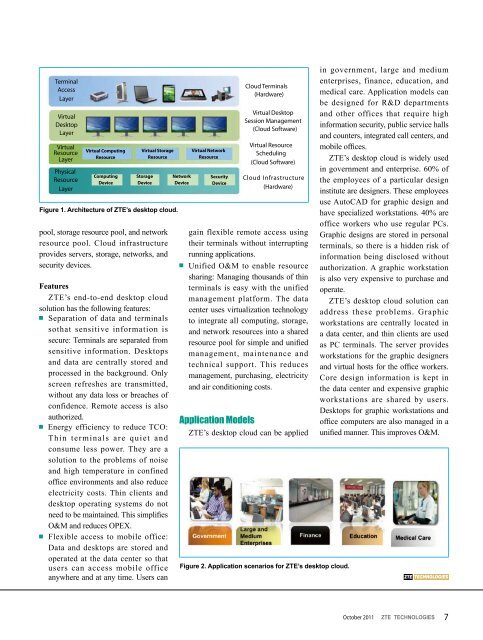PDF download - ZTE
PDF download - ZTE
PDF download - ZTE
You also want an ePaper? Increase the reach of your titles
YUMPU automatically turns print PDFs into web optimized ePapers that Google loves.
Terminal<br />
Access<br />
Layer<br />
Virtual<br />
Desktop<br />
Layer<br />
Virtual<br />
Resource<br />
Layer<br />
Physical<br />
Resource<br />
Layer<br />
Virtual Computing<br />
Resource<br />
Computing<br />
Device<br />
Virtual Storage<br />
Resource<br />
Storage<br />
Device<br />
Figure 1. Architecture of <strong>ZTE</strong>’s desktop cloud.<br />
pool, storage resource pool, and network<br />
resource pool. Cloud infrastructure<br />
provides servers, storage, networks, and<br />
security devices.<br />
Features<br />
<strong>ZTE</strong>’s end-to-end desktop cloud<br />
solution has the following features:<br />
Separation of data and terminals<br />
sothat sensitive information is<br />
secure: Terminals are separated from<br />
sensitive information. Desktops<br />
and data are centrally stored and<br />
processed in the background. Only<br />
screen refreshes are transmitted,<br />
without any data loss or breaches of<br />
confidence. Remote access is also<br />
authorized.<br />
Energy efficiency to reduce TCO:<br />
Thin terminals are quiet and<br />
consume less power. They are a<br />
solution to the problems of noise<br />
and high temperature in confined<br />
office environments and also reduce<br />
electricity costs. Thin clients and<br />
desktop operating systems do not<br />
need to be maintained. This simplifies<br />
O&M and reduces OPEX.<br />
Flexible access to mobile office:<br />
Data and desktops are stored and<br />
operated at the data center so that<br />
users can access mobile office<br />
anywhere and at any time. Users can<br />
Network<br />
Device<br />
Virtual Network<br />
Resource<br />
Security<br />
Device<br />
Cloud Terminals<br />
(Hardware)<br />
Virtual Desktop<br />
Session Management<br />
(Cloud Software)<br />
Virtual Resource<br />
Scheduling<br />
(Cloud Software)<br />
Cloud Infrastructure<br />
(Hardware)<br />
gain flexible remote access using<br />
their terminals without interrupting<br />
running applications.<br />
Unified O&M to enable resource<br />
sharing: Managing thousands of thin<br />
terminals is easy with the unified<br />
management platform. The data<br />
center uses virtualization technology<br />
to integrate all computing, storage,<br />
and network resources into a shared<br />
resource pool for simple and unified<br />
management, maintenance and<br />
technical support. This reduces<br />
management, purchasing, electricity<br />
and air conditioning costs.<br />
Application Models<br />
<strong>ZTE</strong>’s desktop cloud can be applied<br />
Figure 2. Application scenarios for <strong>ZTE</strong>’s desktop cloud.<br />
in government, large and medium<br />
enterprises, finance, education, and<br />
medical care. Application models can<br />
be designed for R&D departments<br />
and other offices that require high<br />
information security, public service halls<br />
and counters, integrated call centers, and<br />
mobile offices.<br />
<strong>ZTE</strong>’s desktop cloud is widely used<br />
in government and enterprise. 60% of<br />
the employees of a particular design<br />
institute are designers. These employees<br />
use AutoCAD for graphic design and<br />
have specialized workstations. 40% are<br />
office workers who use regular PCs.<br />
Graphic designs are stored in personal<br />
terminals, so there is a hidden risk of<br />
information being disclosed without<br />
authorization. A graphic workstation<br />
is also very expensive to purchase and<br />
operate.<br />
<strong>ZTE</strong>’s desktop cloud solution can<br />
address these problems. Graphic<br />
workstations are centrally located in<br />
a data center, and thin clients are used<br />
as PC terminals. The server provides<br />
workstations for the graphic designers<br />
and virtual hosts for the office workers.<br />
Core design information is kept in<br />
the data center and expensive graphic<br />
workstations are shared by users.<br />
Desktops for graphic workstations and<br />
office computers are also managed in a<br />
unified manner. This improves O&M.<br />
October 2011<br />
<strong>ZTE</strong> TECHNOLOGIES<br />
7

















